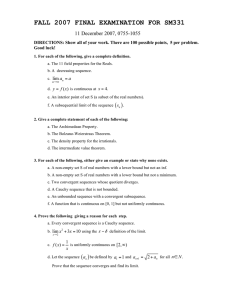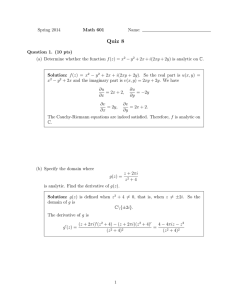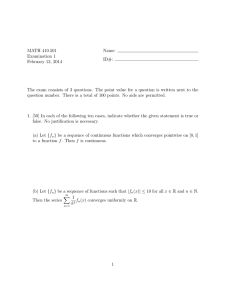Solutions to Homework 4 Math 4200, Summer 2009 July 8, 2009
advertisement
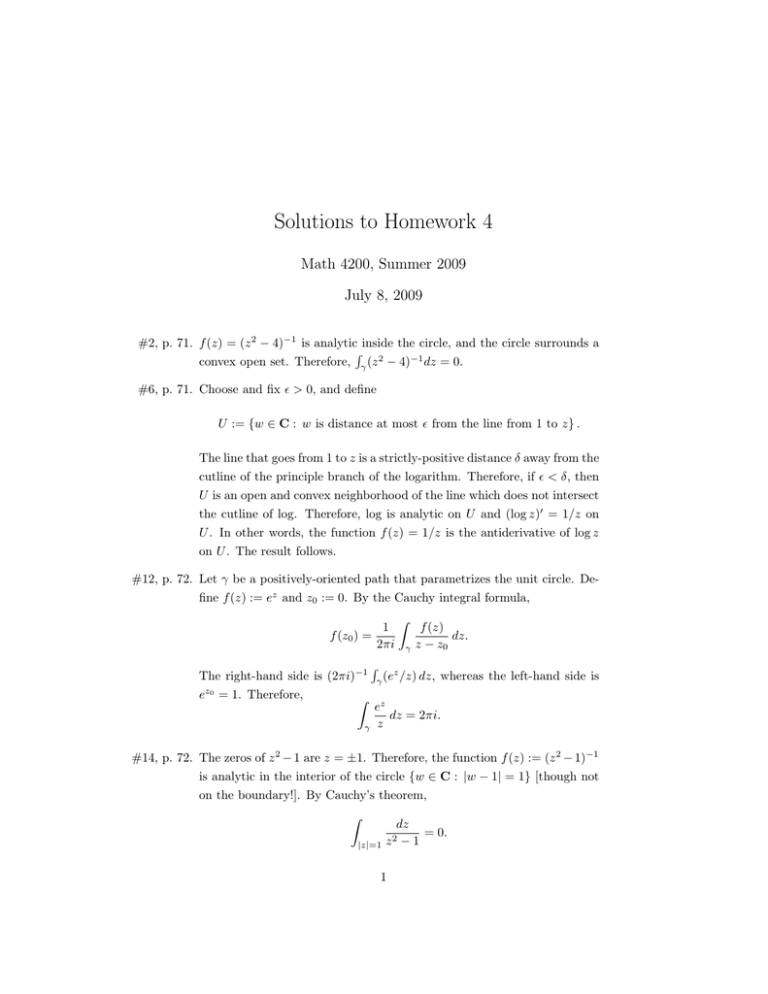
Solutions to Homework 4
Math 4200, Summer 2009
July 8, 2009
#2, p. 71. f (z) = (z 2 − 4)−1 is analytic inside the circle, and the circle surrounds a
R
convex open set. Therefore, γ (z 2 − 4)−1 dz = 0.
#6, p. 71. Choose and fix > 0, and define
U := {w ∈ C : w is distance at most from the line from 1 to z} .
The line that goes from 1 to z is a strictly-positive distance δ away from the
cutline of the principle branch of the logarithm. Therefore, if < δ, then
U is an open and convex neighborhood of the line which does not intersect
the cutline of log. Therefore, log is analytic on U and (log z)0 = 1/z on
U . In other words, the function f (z) = 1/z is the antiderivative of log z
on U . The result follows.
#12, p. 72. Let γ be a positively-oriented path that parametrizes the unit circle. Define f (z) := ez and z0 := 0. By the Cauchy integral formula,
1
2πi
f (z0 ) =
The right-hand side is (2πi)−1
ez0 = 1. Therefore,
Z
γ
R
γ
Z
γ
f (z)
dz.
z − z0
(ez /z) dz, whereas the left-hand side is
ez
dz = 2πi.
z
#14, p. 72. The zeros of z 2 − 1 are z = ±1. Therefore, the function f (z) := (z 2 − 1)−1
is analytic in the interior of the circle {w ∈ C : |w − 1| = 1} [though not
on the boundary!]. By Cauchy’s theorem,
Z
|z|=1
dz
= 0.
z2 − 1
1
Also, f is analytic in the annulus {w : 1 < |w| < 3}. Therefore (why?),
Z
|z|=3
Z
dz
−
z2 − 1
Add the two displays to find that
|z|=1
R
|z|=3
dz
= 0.
z2 − 1
(z 2 − 1)−1 dz = 0.
#1, p. 87. Clearly,
1
1
1
sup − 0 = sup
=
→0
nr
|z|≥r n|z|
|z|≥r nz
as n → ∞.
Therefore, the sequence converges to zero uniformly on {z ∈ C : |z| ≥ r},
regardless of how small r is. On the other hand,
1
1
sup − 0 = sup
= ∞ 6→ 0.
z6=0 n|z|
z6=0 nz
#6, p. 87. We have the bound |k 2 − z| ≥ k 2 − |z| ≥ k 2 − r, uniformly for all z such
that |z| ≤ r. Therefore, if k 2 ≥ 2r then
1 1
1
2
k 2 − z ≤ k 2 − r ≤ k 2 − (k 2 /2) = k 2 .
That is,
X 1 X
≤2
k −2 < ∞.
2
k −z
√
√
k≥ 2r
Of course,
2
−1
√
1≤k< 2r (k −z)
P
(1)
k≥ 2r
converges uniformly for z ∈ Er , because it
is a finite sum. Therefore, the Weiertrass M-test tells us that the infinite
sum is convergent uniformly on Er .
#7, p. 87. If k is a positive integer and z = x + iy ∈ C, then k z = k x k iy = k x eiy log k ,
and therefore |k z | = k x = k Re(z) . Therefore, if Re(z) > s with s > 1, then
|k z | ≥ k s , whence
∞ ∞
X
1 X
≤
k −s < ∞.
kz k=1
k=1
The M-test does the rest.
#15, p. 88. Let h(w) := (1 + w)−1 . Then, h0 (w) = −(1 + w)−2 , h00 (w) = 2(1 + w)−3 ,
etc. In particular, h(n) (0) = (−1)n n!, and so we have the power-series
2
representation
∞
X
1
=
(−1)n wn .
1 + w n=0
The preceding power series converges uniformly on {z ∈ C : |z| < 1}.
Because we can integrate a power series term-by-term where it converges
uniformly, it follows that if |z| < 1, then
Z
0
z
Z z
Z z n+1 0
∞
∞
X
X
dw
w
n
n
n
dw
=
w dw =
(−1)
(−1)
1 + w n=0
n
+1
0
0
n=0
=
∞
X
(−1)n
n=0
z n+1
.
n+1
Now, this is a power series about zero whose nth coefficient is cn :=
(−1)n /(n + 1). Note that
|cn |
1/n
= (n + 1)
log(n + 1)
= exp −
n
−1/n
.
Therefore, lim supn→∞ |cn |1/n = limn→∞ |cn |1/n = 1. This is the radius
of uniform convergence.
Therefore,
∞
X
z n+1
(−1)
=
n+1
n=0
n
Z
0
z
dw
= ln(1 + z),
1+w
for |z| < 1, because 1/(1 + w) is the antiderivative of ln(1 + w) in D1 (0).
#9, p. 95. We did this as a theorem in the lectures (see also Theorem 3.4.2).
#11, p. 95. Correction: p(z) = a3 z 3 + a2 z 2 + a1 z + a0 . Now suppose |p(z)| ≤ 1 on
{z ∈ C : |z| = 1}. According to Cauchy’s estimate (Theorem 3.2.9),
6|a3 | = |p000 (0)| ≤ 3! = 6. Therefore, |a3 | ≤ 1 (and hence ≤ 6).
3
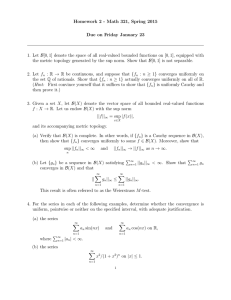

![(1) If f : [0, 1] −→ R is continuous... Z f (x)dx = f (c).](http://s2.studylib.net/store/data/010518093_1-908690675bd939e7f32dbd691b6cbb60-300x300.png)
